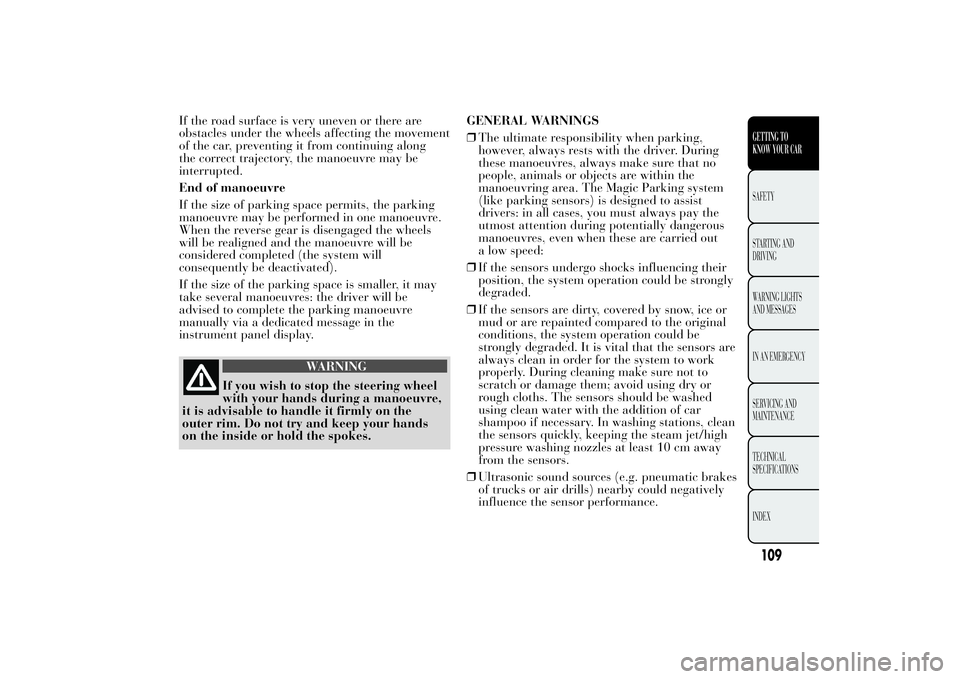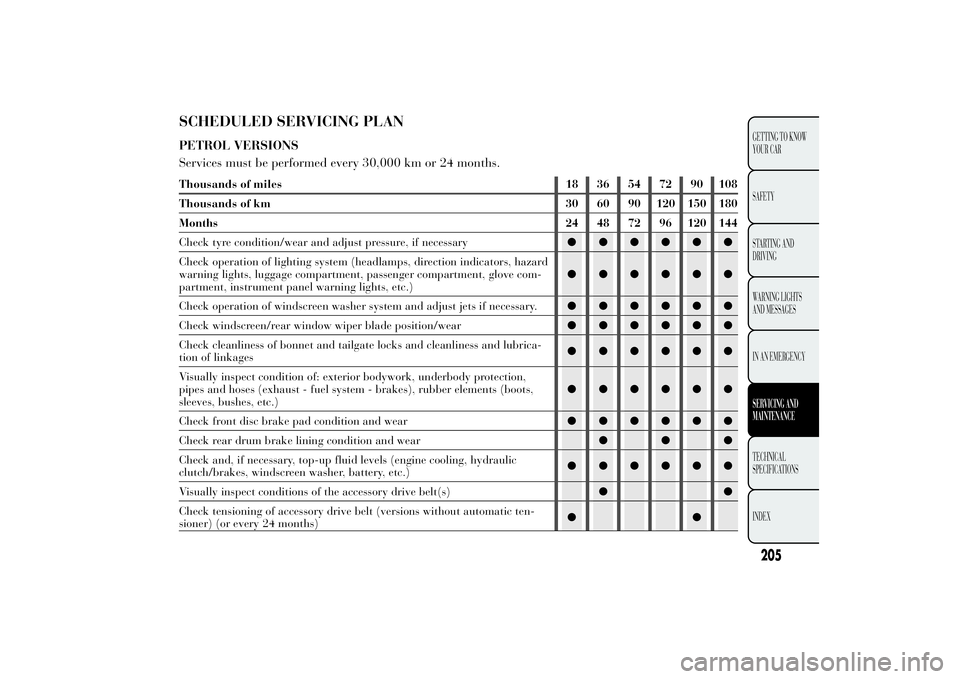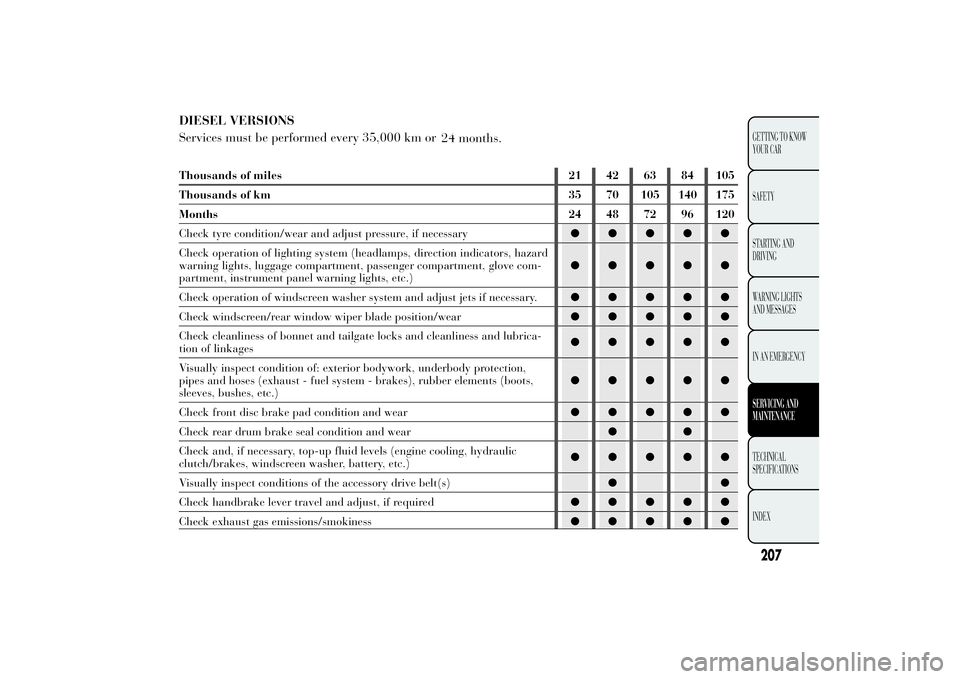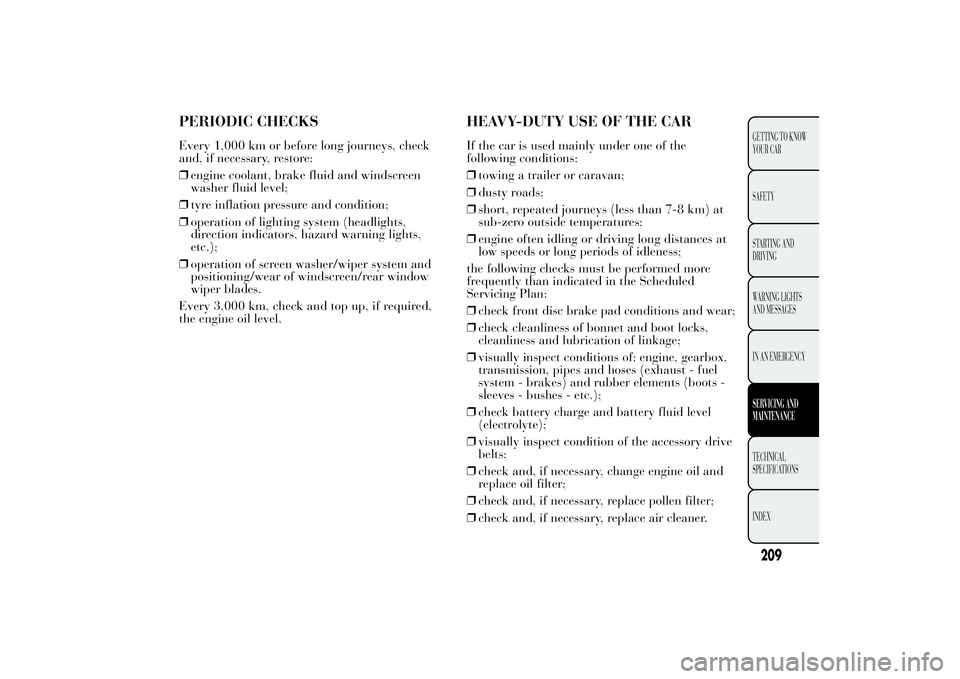brakes Lancia Ypsilon 2012 Owner handbook (in English)
[x] Cancel search | Manufacturer: LANCIA, Model Year: 2012, Model line: Ypsilon, Model: Lancia Ypsilon 2012Pages: 307, PDF Size: 13.3 MB
Page 92 of 307

ESC SYSTEM (Electronic Stability
Control)This is an electronic system that controls car
stability in the event of tyre grip loss, helping
maintain directional control. The system is
capable of recognising potentially dangerous
situations in terms of the stability and intervenes
automatically on the brakes in a differentiated
manner for the four wheels in order to provide a
stabilizing torque.
The ESC system also includes the following
subsystems:
❒Hill Holder
❒ASR
❒Brake Assist
❒MSR
❒HBASYSTEM INTERVENTION
It is signalled by the flashing of theESCwarning
light on the instrument panel, to inform the driver
that the car is in critical stability and grip
conditions.
SYSTEM ACTIVATION
The ESC system switches on automatically when
the engine is started and cannot be switched off.
HILL HOLDER SYSTEM
This system is an integral part of the ESC system
and facilitates starting on slopes.
It is activated automatically in the following
instances:
❒uphill: car stationary on a road with a gradient
higher than 5%, engine running, brake pressed
and gearbox in neutral or gear (other than
reverse) engaged;
❒downhill: car stationary on a road with a
gradient higher than 5%, engine running, brake
pressed and reverse gear engaged.
90GETTING TO
KNOW YOUR CAR
SAFETY
STARTING AND
DRIVING
WARNING LIGHTS
AND MESSAGES
IN AN EMERGENCY
SERVICING AND
MAINTENANCE
TECHNICAL
SPECIFICATIONS
INDEX
Page 111 of 307

If the road surface is very uneven or there are
obstacles under the wheels affecting the movement
of the car, preventing it from continuing along
the correct trajectory, the manoeuvre may be
interrupted.
End of manoeuvre
If the size of parking space permits, the parking
manoeuvre may be performed in one manoeuvre.
When the reverse gear is disengaged the wheels
will be realigned and the manoeuvre will be
considered completed (the system will
consequently be deactivated).
If the size of the parking space is smaller, it may
take several manoeuvres: the driver will be
advised to complete the parking manoeuvre
manually via a dedicated message in the
instrument panel display.
WARNING
If you wish to stop the steering wheel
with your hands during a manoeuvre,
it is advisable to handle it firmly on the
outer rim. Do not try and keep your hands
on the inside or hold the spokes.GENERAL WARNINGS
❒The ultimate responsibility when parking,
however, always rests with the driver. During
these manoeuvres, always make sure that no
people, animals or objects are within the
manoeuvring area. The Magic Parking system
(like parking sensors) is designed to assist
drivers: in all cases, you must always pay the
utmost attention during potentially dangerous
manoeuvres, even when these are carried out
a low speed:
❒If the sensors undergo shocks influencing their
position, the system operation could be strongly
degraded.
❒If the sensors are dirty, covered by snow, ice or
mud or are repainted compared to the original
conditions, the system operation could be
strongly degraded. It is vital that the sensors are
always clean in order for the system to work
properly. During cleaning make sure not to
scratch or damage them; avoid using dry or
rough cloths. The sensors should be washed
using clean water with the addition of car
shampoo if necessary. In washing stations, clean
the sensors quickly, keeping the steam jet/high
pressure washing nozzles at least 10 cm away
from the sensors.
❒Ultrasonic sound sources (e.g. pneumatic brakes
of trucks or air drills) nearby could negatively
influence the sensor performance.
109GETTING TO
KNOW YOUR CARSAFETY
STARTING AND
DRIVING
WARNING LIGHTS
AND MESSAGES
IN AN EMERGENCY
SERVICING AND
MAINTENANCE
TECHNICAL
SPECIFICATIONS
INDEX
Page 207 of 307

SCHEDULED SERVICING PLANPETROL VERSIONS
Services must be performed every 30,000 km or 24 months.Thousands of miles 18 36 54 72 90 108
Thousands of km 30 60 90 120 150 180
Months 24 48 72 96 120 144
Check tyre condition/wear and adjust pressure, if necessary●●●●●●
Check operation of lighting system (headlamps, direction indicators, hazard
warning lights, luggage compartment, passenger compartment, glove com-
partment, instrument panel warning lights, etc.)●●●●●●
Check operation of windscreen washer system and adjust jets if necessary.●●●●●●
Check windscreen/rear window wiper blade position/wear●●●●●●
Check cleanliness of bonnet and tailgate locks and cleanliness and lubrica-
tion of linkages●●●●●●
Visually inspect condition of: exterior bodywork, underbody protection,
pipes and hoses (exhaust - fuel system - brakes), rubber elements (boots,
sleeves, bushes, etc.)●●●●●●
Check front disc brake pad condition and wear●●●●●●
Check rear drum brake lining condition and wear●●●
Check and, if necessary, top-up fluid levels (engine cooling, hydraulic
clutch/brakes, windscreen washer, battery, etc.)●●●●●●
Visually inspect conditions of the accessory drive belt(s)●●
Check tensioning of accessory drive belt (versions without automatic ten-
sioner) (or every 24 months)●●
205GETTING TO KNOW
YOUR CAR
SAFETY
STARTING AND
DRIVING
WARNING LIGHTS
AND MESSAGES
IN AN EMERGENCYSERVICING AND
MAINTENANCETECHNICAL
SPECIFICATIONS
INDEX
Page 209 of 307

DIESEL VERSIONS
Services must be performed every 35,000 km or
24 months.Thousands of miles 21 42 63 84 105
Thousands of km 35 70 105 140 175
Months 24 48 72 96 120
Check tyre condition/wear and adjust pressure, if necessary●●●●●
Check operation of lighting system (headlamps, direction indicators, hazard
warning lights, luggage compartment, passenger compartment, glove com-
partment, instrument panel warning lights, etc.)●●●●●
Check operation of windscreen washer system and adjust jets if necessary.●●●●●
Check windscreen/rear window wiper blade position/wear●●●●●
Check cleanliness of bonnet and tailgate locks and cleanliness and lubrica-
tion of linkages●●●●●
Visually inspect condition of: exterior bodywork, underbody protection,
pipes and hoses (exhaust - fuel system - brakes), rubber elements (boots,
sleeves, bushes, etc.)●●●●●
Check front disc brake pad condition and wear●●●●●
Check rear drum brake seal condition and wear●●
Check and, if necessary, top-up fluid levels (engine cooling, hydraulic
clutch/brakes, windscreen washer, battery, etc.)●●●●●
Visually inspect conditions of the accessory drive belt(s)●●
Check handbrake lever travel and adjust, if required●●●●●
Check exhaust gas emissions/smokiness●●●●●
207GETTING TO KNOW
YOUR CAR
SAFETY
STARTING AND
DRIVING
WARNING LIGHTS
AND MESSAGES
IN AN EMERGENCYSERVICING AND
MAINTENANCETECHNICAL
SPECIFICATIONS
INDEX
Page 211 of 307

PERIODIC CHECKSEvery 1,000 km or before long journeys, check
and, if necessary, restore:
❒engine coolant, brake fluid and windscreen
washer fluid level;
❒tyre inflation pressure and condition;
❒operation of lighting system (headlights,
direction indicators, hazard warning lights,
etc.);
❒operation of screen washer/wiper system and
positioning/wear of windscreen/rear window
wiper blades.
Every 3,000 km, check and top up, if required,
the engine oil level.
HEAVY-DUTY USE OF THE CARIf the car is used mainly under one of the
following conditions:
❒towing a trailer or caravan;
❒dusty roads;
❒short, repeated journeys (less than 7-8 km) at
sub-zero outside temperatures;
❒engine often idling or driving long distances at
low speeds or long periods of idleness;
the following checks must be performed more
frequently than indicated in the Scheduled
Servicing Plan:
❒check front disc brake pad conditions and wear;
❒check cleanliness of bonnet and boot locks,
cleanliness and lubrication of linkage;
❒visually inspect conditions of: engine, gearbox,
transmission, pipes and hoses (exhaust - fuel
system - brakes) and rubber elements (boots -
sleeves - bushes - etc.);
❒check battery charge and battery fluid level
(electrolyte);
❒visually inspect condition of the accessory drive
belts;
❒check and, if necessary, change engine oil and
replace oil filter;
❒check and, if necessary, replace pollen filter;
❒check and, if necessary, replace air cleaner.
209GETTING TO KNOW
YOUR CAR
SAFETY
STARTING AND
DRIVING
WARNING LIGHTS
AND MESSAGES
IN AN EMERGENCYSERVICING AND
MAINTENANCETECHNICAL
SPECIFICATIONS
INDEX
Page 235 of 307

BRAKESVersions Front service brakes Rear service brakes Parking brake
0.9 TwinAir 85 HPSelf-ventilated discDrum, self-centring shoes
with control cylinder for
each wheel
Controlled by hand lever,
acting on the rear brakes 1.2 8V 69 HPDiscDrum, self-centring shoes
with control cylinder for
each wheel
1.3 16V MultiJetSelf-ventilated discDrum, self-centring shoes
with control cylinder for
each wheelIMPORTANT Water, ice and salt spread on the roads may deposit on the brake disks reducing braking
efficiency the first time the brakes are applied.
233GETTING TO KNOW
YOUR CAR
SAFETY
STARTING AND
DRIVING
WARNING LIGHTS
AND MESSAGES
IN AN EMERGENCY
SERVICING AND
MAINTENANCETECHNICAL
SPECIFICATIONSINDEX
Page 250 of 307

UseFluid and lubricant features
for a correct use of the carGenuine fluids and
lubricantsApplications
Lubricants and
greases for motion
transmissionSAE 75W grade synthetic
lubricant. FIAT Classification
9.55550-MZ6TUTELA
TRANSMISSION
GEARFORCE
Contractual Technical
Reference No. F002.F10Mechanical gearbox and
differential
Molybdenum disulphide grease,
for use at high temperatures.
Consistency NL.G.I. 1-2. FIAT
Classification 9.55580TUTELA ALL STAR
Contractual Technical
Reference No. F702.G07Wheel side constant
velocity joints
Grease for constant velocity
joints with low friction
coefficient. Consistency NL.G.I.
0-1. FIAT Classification
9.55580TUTELA STAR 700
Contractual Technical
Reference No. F701.C07Differential side constant
velocity joints
Brake fluidSynthetic fluid for brake and
clutch systems. Exceeds
specifications: FMVSS no. 116
DOT 4, ISO 4925 SAE J1704
FIAT Classification 9.55597TUTELA TOP 4
Contractual Technical
Reference No. F001.A93Hydraulic brakes and
hydraulic clutch controls
248
GETTING TO KNOW
YOUR CAR
SAFETY
STARTING AND
DRIVING
WARNING LIGHTS
AND MESSAGES
IN AN EMERGENCY
SERVICING AND
MAINTENANCE
TECHNICAL
SPECIFICATIONS
INDEX
Page 301 of 307

Index
ABS (system) ....................... 88
ABS system .......................... 88
Airbag ................................ 137
– Deactivation of
passenger side front
airbag and side bag ........ 139
– side bag .......................... 139
– window bag .................... 140
Airbags
– front ............................... 137
Air cleaner .......................... 217
Ashtray ................................ 71
ASR system .......................... 91
ASR (system) ....................... 91
Automatic climate control .... 45
– controls............................ 45
– maintenance .................... 52Battery (charge) ................. 199
Battery................................ 217
– advice for extending
lifetime ........................... 217
– replacement.................... 217
Body versions...................... 230
Bodywork– bodywork codes.............. 230
– maintenance ................... 224
– protection from
atmospheric agents ......... 223
– warranty ........................ 224
Bonnet ................................. 84
Brake Assist system .............. 92
Brake Assist (system) ........... 92
Brakes
– brake fluid level ............. 216
– specifications .................. 233
bulb replacement......... 182-184
Bulb replacement
– external lights................. 180
– interior lights.................. 186
Car dimensions................... 242
Carrying children safely ...... 129
– Carrying children safely . 129
– child seats ...................... 136
– Setup for "Isofix" child
seat ................................ 134
Central air diffusers ............. 40
Changing a wheel ............... 169
Checking levels .... 211-212-213
Child seats (compliance
for use) ............................. 133Cigar lighter ......................... 71
CITY function ...................... 98
Cleaning and maintenance
– bodywork ....................... 223
– car interior ..................... 226
– engine compartment ....... 225
– front headlights .............. 225
– Leather parts.................. 227
– Leather seats .................. 227
– Plastic and coated parts.. 226
– seats ............................... 226
– windows ......................... 225
Climate control .................... 40
– Passenger compartment
air diffusers ..................... 41
Climatic comfort .................. 41
Clutch................................. 232
CO
2emissions..................... 251
Conditions of use ................ 150
Control panel and
instruments ........................ 6
Controls .......................... 67-78
Cruise control....................... 61
D
ashboard........................... 5
Daytime running lights
(DRL)
299GETTING TO
KNOW YOUR CAR
SAFETY
STARTING AND
DRIVING
WARNING LIGHTS
AND MESSAGES
IN AN EMERGENCY
SERVICING AND
MAINTENANCE
TECHNICAL
SPECIFICATIONSINDEX